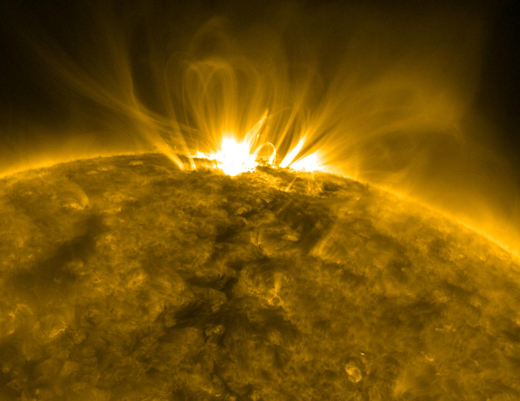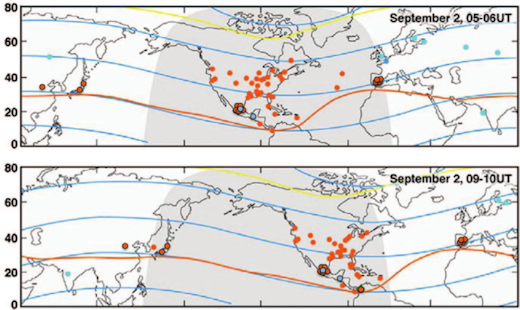According to spaceweather.com it’s 164 YEARS since: A billion-ton coronal mass ejection (CME) slammed into Earth’s magnetic field.
Apparently, the skies in the Rocky Mountains were illuminated by the Northern Lights and so many energy particles struck the Earth that they changed the chemistry of polar ice.
Hard to believe? Spaceweather.com reports that it really happened. This map shows where auroras were sighted in the early hours of Sept. 2, 1859:
spaceweather.com reports: As the day unfolded, the gathering storm electrified telegraph lines, shocking technicians and setting their telegraph papers on fire. The “Victorian Internet” was knocked offline. Magnetometers around the world recorded strong disturbances in the planetary magnetic field for more than a week.
The cause of all this was an extraordinary solar flare witnessed the day before by British astronomer Richard Carrington. His sighting on Sept. 1, 1859, marked the discovery of solar flares and foreshadowed a new field of study: space weather. According to a NASA-funded study by the National Academy of Sciences, if a similar “Carrington Event” occurred today, it could cause substantial damage to society’s high-tech infrastructure and require years for complete recovery.
We have reported on the Carrington effect before, and it’s modern equivalent, the EMP, here, here and here. And we have some advice for preserving vital electronics in a Faraday Cage here.
Could it happen again? Yes. And we’re overdue.
In a paper published just a few months ago, researchers from the University of Birmingham used Extreme Value Theory to estimate the average time between “Carrington-like flares.” Their best answer: ~100 years. In other words, we may be overdue for a really big storm.
Read their original research here. (Here’s the Abstract from their paper:
By their very nature, extreme space weather events occur rarely, and therefore, statistical methods are required to determine the probability of their occurrence. Space weather events can be characterized by a number of natural phenomena such as X‐ray (solar) flares, solar energetic particle fluxes, coronal mass ejections, and various geophysical indices (such as Dst, Kp, and F10.7). In this paper extreme value theory (EVT) is used to investigate the probability of extreme solar flares. Previous work has assumed that the distribution of solar flares follows a power law. However, such an approach can lead to a poor estimation of the return times of flares due to uncertainties in the tails of the probability distribution function. Using EVT and Geostationary Operational Environmental Satellites X‐ray flux data, it is shown that the expected 150 year return level is approximately an X60 flare while a Carrington‐like flare is a one in a 100 year event. In the worst case the 150 year return level is an X90 flare while a Carrington flare is a one in 30 year event. It is also shown that the EVT results are consistent with flare data from the Kepler space telescope mission.)


